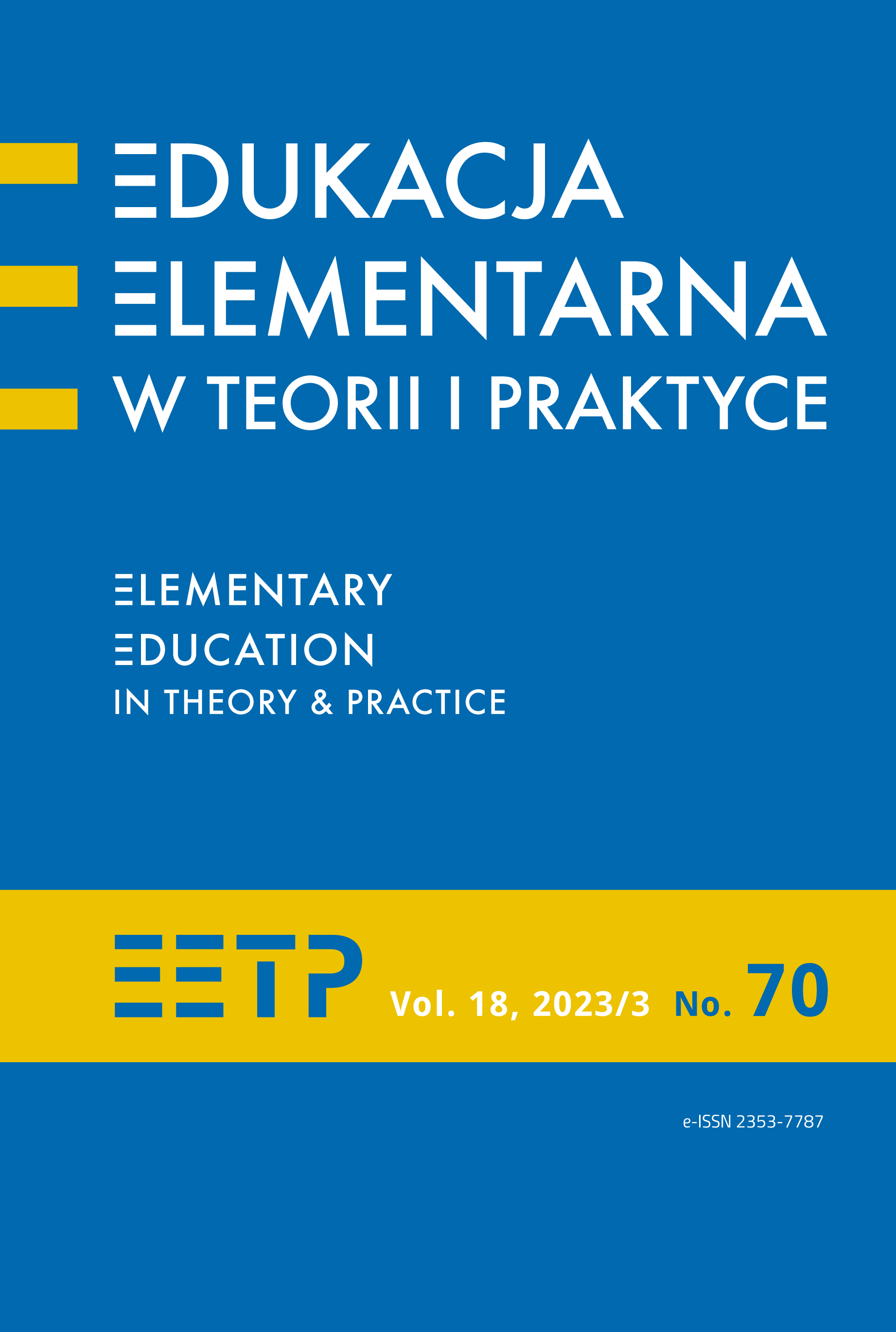Zmysł równowagi u dzieci z przedszkoli tradycyjnych i leśnych
Abstrakt
Obszarem zainteresowania w tym artykule jest zmysł równowagi u dzieci w wieku przedszkolnym, jego celem przedstawienie badań dotyczących porównania zdolności utrzymania równowagi w próbach statycznych i dynamicznych dzieci uczęszczających do przedszkoli tradycyjnych i do przedszkoli leśnych. Inspiracją do napisania były obserwacje własne wskazujące, że dzieci z przedszkoli leśnych (od 3 roku życia) znacznie lepiej radzą sobie z pokonywaniem naturalnych przeszkód i z wykonywaniem trudnych zadań koordynacyjnych wymagających utrzymania równowagi, niż dzieci z innych placówek przedszkolnych.
W części wstępnej artykułu przedstawiono znaczenie układu przedsionkowego w aspekcie anatomicznym i pedagogicznym. Badania polegały na przeprowadzeniu 2 prób sprawdzających równowagę statyczną – stanie jednonóż z oczami otwartymi i zamkniętymi i 2 prób sprawdzających równowagę dynamiczną – swobodne przejście po belce i przejście krokiem mierniczym. Z badań własnych autorki wynika, że we wszystkich próbach dzieci z przedszkoli leśnych uzyskały lepsze rezultaty niż dzieci z przedszkoli tradycyjnych. Wnioskowanie statystyczne z wykorzystaniem rozkładu z (normalnego) przeprowadzono na podstawie testu U Manna Whitney`a. Test ten wykazał, że wspomniane różnice były istotne statystycznie. Artykuł kończą rekomendacje ogólnopedagogiczne i praktycznoedukacyjne.
Bibliografia
Arystoteles. (b.d.). O duszy (P. Siwek, tłum.). https://sady.up.krakow.pl/fil.arystoteles.oduszy.htm
Baza Marzeń. (b.d.). Trójmiejski Leśny Ogród Wolnych Dzieci. Baza Marzeń. https://bazamarzen.pl/?page_id=879
Borkowska, M. (2018). Integracja sensoryczna w rozwoju dziecka. Podstawy neurofizjologiczne. Harmonia Universalis.
Cassan, A. (2008). Atlas ludzkiego ciała. Anatomia, fizjologia, zdrowie. Poradnik rodzinny (S. Kaczorowski, tłum.). Bauer-Welbild Media.
Condon, C. i Cremin, K. (2014). Static balance norms in children. Physiotherapy Research International, 19(1), 1–7.
Goddard, S. (2004). Odruchy, uczenie i zachowanie. Klucz do umysłu dziecka. Nieinwazyjne metody rozwiązywania problemów z uczeniem się i zachowaniem (M. Macińska, tłum.). Międzynarodowy Instytut Neurokinezjologii Rozwoju Ruchowego i Integracji Odruchów.
Hannaford, C. (1995). Zmyślne ruchy, które doskonalą umysł (M. Szpala, tłum.). Polskie Stowarzyszenie Kinezjologów, Medyk.
Harwas-Napierała, B. i Trempała, J. (red.). (2005). Psychologia rozwoju człowieka. Charakterystyka okresów życia człowieka. PWN.
Held-Ziółkowska, M. (2006). Równowaga statyczna i dynamiczna ciała. Część 1: Organizacja zmysłowa i biomechanika układu równowagi. Magazyn Otolaryngologiczny, 5(2), 39–46.
Hertel, J., Braham, R.A., Hale, S.A. i Olmsted-Kramer, L.C. (2006). Simplifying the star excursion balance test: Analyses of subjects with and without chronic ankle instability. Journal of Orthopaedic Sports Physical Therapy, 36(3), 131–137.
Maas, V.F. (1998). Uczenie się przez zmysły. Wprowadzenie do teorii integracji sensorycznej dla rodziców i specjalistów (E. Grzybowska, Z. Przyrowski i M. Ślifirska, tłum.). Wydawnictwa Szkolne i Pedagogiczne.
Mosse, H. L. (1982). A complete handbook of children’s reading disorders: A critical evaluation of their clinical, educational and social dimensions. T. 1–2. Human Sciences Press.
Nauka w Polsce. (2010, 25 lutego). WHO, Dzisiejsze dzieci mogą żyć krócej niż ich rodzice. Nauka w Polsce. https://naukawpolsce.pl/aktualnosci/news%2C370482%2Cwho-dzisiejsze-dzieci-moga-zyc-krocej-niz-ich-rodzice.html
Nauka w Polsce. (2016, 8 grudnia). Dr Dobosz: dzieci i młodzież coraz mniej sprawne fizycznie. Nauka w Polsce. https://naukawpolsce.pl/aktualnosci/news%2C412316%2Cdr-dobosz-dzieci-i-mlodziez-coraz-mniej-sprawne-fizycznie.html
Nitecka-Walerych, A. (2019). Leśne przedszkola – odpowiedź edukacji na potrzeby dzieci. Pedagogika. Studia i Rozprawy, 28, 229–239.
Paszko-Patej, G., Terlikowski, R., Kułak, W., Sienkiewicz, D. i Okurowska-Zawada, B. (2011). Czynniki wpływające na proces kształtowania równowagi dziecka oraz możliwości jej obiektywnej oceny. Neurologia Dziecięca, 20(41), 121–127.
Rozporządzenie Ministra Edukacji Narodowej z dnia 14 lutego 2017 r. w sprawie podstawy programowej wychowania przedszkolnego oraz podstawy programowej kształcenia ogólnego dla szkoły podstawowej. Dz. U. 2017, poz. 356. (2017). (Polska). https://isap.sejm.gov.pl/isap.nsf/download.xsp/WDU20170000356/O/D20170356.pdf
Szafron, A. (2022). Rola układu przedsionkowego w rozwoju dziecka. http://www.p2.laziska.pl/images/stories/1/przes.pdf
Sobera, M. (2010). Charakterystyka procesu utrzymywania równowagi ciała u dzieci w wieku 2–7 lat. Wydawnictwo Akademii Wychowania Fizycznego we Wrocławiu.
Wytrębowicz, A. (2016). Ocena utrzymania równowagi przez dzieci w wieku 3–5 lat. Zeszyty Naukowe WSKFiT, 11, 35–42.
Copyright (c) 2023 Edukacja Elementarna w Teorii i Praktyce

Utwór dostępny jest na licencji Creative Commons Uznanie autorstwa – Bez utworów zależnych 4.0 Międzynarodowe.
1. Autor zgłaszając swój artykuł oświadcza, że jest Autorem artykułu (zwanego dalej Utworem) i:
- przysługują mu wyłączne i nieograniczone prawa autorskie do Utworu,
- jest uprawniony/a do rozporządzania prawami autorskimi do Utworu.
Oświadcza, że nie narusza praw autorskich osób trzecich i praw prawnych.
Oświadcza, że nie występuje żaden konflikt interesów.
2. Udziela Uniwersytetowi Ignatianum w Krakowie nieodpłatnej, niewyłącznej, nieograniczonej terytorialnie licencji do korzystania z Utworu na następujących polach eksploatacji:
- utrwalania utworu w formie papierowej, a także na nośniku cyfrowym lub magnetycznym;
- zwielokrotnienia utworu dowolną techniką, bez ograniczenia ilości wydań i liczby egzemplarzy;
- rozpowszechniania utworu i jego zwielokrotnionych egzemplarzy na jakimkolwiek nośniku, w tym wprowadzenia do obrotu, sprzedaży, użyczenia, najmu;
- wprowadzenia utworu do pamięci komputera;
- rozpowszechniania utworu w sieciach informatycznych, w tym w sieci Internet;
- publicznego wykonania, wystawienia, wyświetlenia, odtworzenia oraz nadawania i reemitowania, a także publicznego udostępniania utworu w taki sposób, aby każdy mógł mieć do niego dostęp w miejscu i czasie przez siebie wybranym;
- w zakresie praw zależnych do Utworu, obejmujących w szczególności prawo do dokonania koniecznych zmian w Utworze, wynikających z opracowania redakcyjnego i metodycznego, a także do dokonania tłumaczenia Utworu na języki obce.
Udzielenie licencji następuje z chwilą przekazania Utworu na rzecz Uniwersytetowi Ignatianum w Krakowie. Uniwersytet Ignatianum w Krakowie jest uprawniony do udzielania dalszych sublicencji do Utworu, w zakresie udzielonego prawa. Licencja jest ograniczona czasowo i zostaje udzielona na okres 15 lat, licząc od daty jej udzielenia.
Wyraża się zgodę i zachęca autorów do publikacji ich tekstu w Internecie (np. w repozytorium instytucji lub na jej stronie internetowej) przed lub podczas procesu składania tekstu jako, że może to prowadzić do korzystnych wymian oraz wcześniejszego i większego cytowania opublikowanego tekstu (Patrz The Effect of Open Access). Zalecamy wykorzystanie dowolnego portalu stowarzyszeń badawczych z niżej wymienionych:




